2014 MERCEDES-BENZ B-CLASS SPORTS ESP
[x] Cancel search: ESPPage 44 of 360
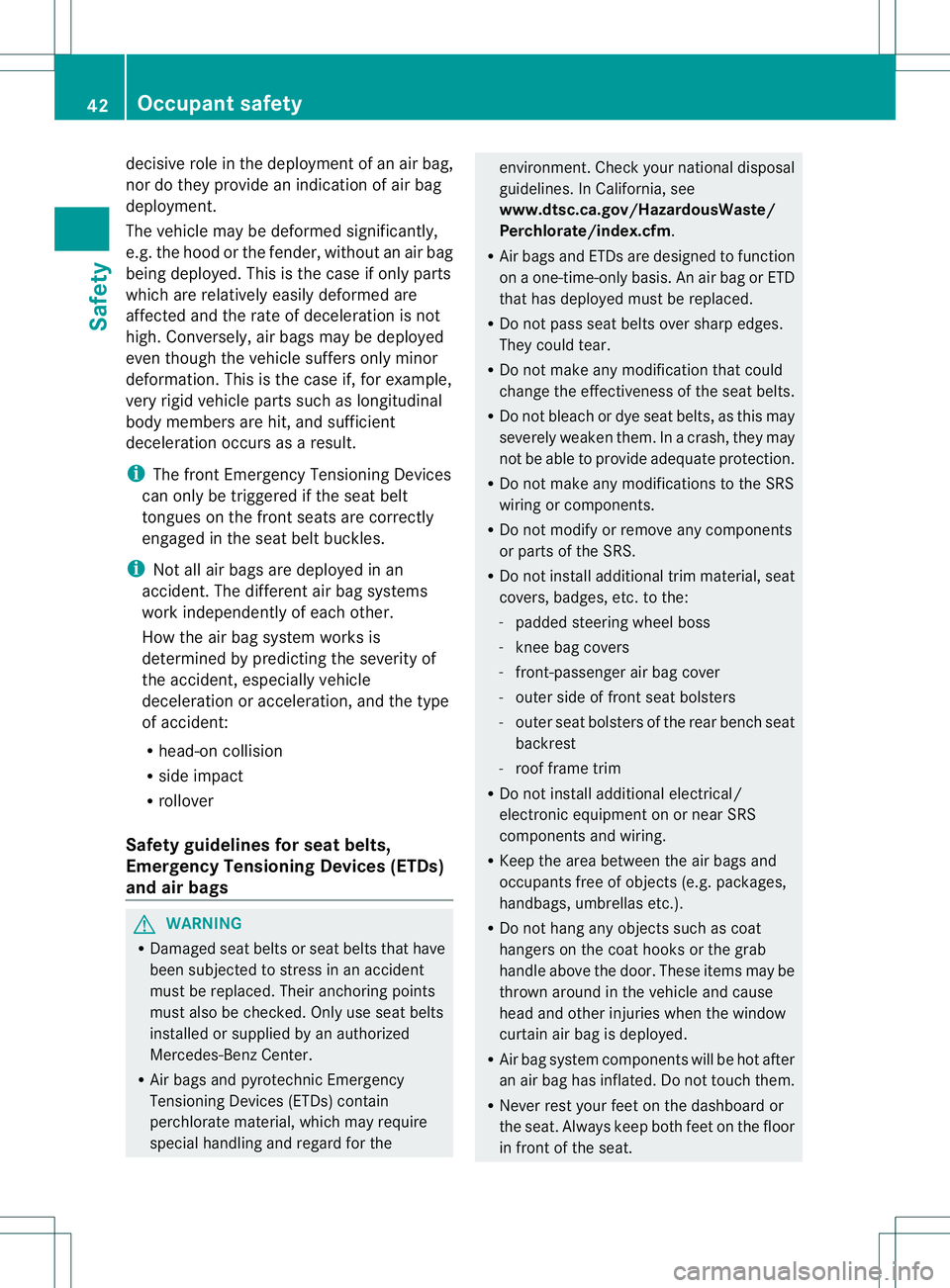
decisive role in the deployment of an air bag,
nor do they provide an indication of air bag
deployment.
The vehicle may be deformed significantly,
e.g. the hood or the fender ,without an air bag
being deployed. This is the case if only parts
which are relatively easily deformed are
affected and the rate of deceleration is not
high. Conversely, air bags may be deployed
even though the vehicle suffers only minor
deformation. This is the case if, for example,
very rigid vehicle parts such as longitudinal
body members are hit, and sufficient
deceleration occurs as aresult.
i The fron tEmergenc yTensioning Devices
can only be triggered if the seat belt
tongues on the fron tseats are correctly
engaged in the seat belt buckles.
i Not all air bags are deployed in an
accident. The differen tair bag systems
work independently of each other.
How the air bag system work sis
determined by predictin gthe severity of
the accident ,especially vehicle
deceleration or acceleration, and the type
of accident:
R head-on collision
R side impact
R rollover
Safety guidelines for seat belts,
Emergency Tensioning Devices (ETDs)
and air bags G
WARNING
R Damaged seat belts or seat belts that have
been subjected to stress in an accident
must be replaced. Their anchorin gpoints
must also be checked. Only use seat belts
installed or supplied by an authorized
Mercedes-Ben zCenter.
R Air bags and pyrotechnic Emergency
Tensionin gDevices (ETDs) contain
perchlorat ematerial, which may require
special handlin gand regar dfor the environment. Check your national disposal
guidelines. In California, see
www.dtsc.ca.gov/HazardousWaste/
Perchlorate/index.cfm.
R Air bags and ETD sare designed to function
on aone-time-only basis. An air bag or ETD
that has deployed must be replaced.
R Do not pass seat belts over sharp edges.
They could tear.
R Do not make any modification that could
change the effectiveness of the seat belts.
R Do not bleach or dye seat belts ,asthis may
severely weaken them. In acrash, the ymay
not be able to provide adequate protection.
R Do not make any modifications to the SRS
wirin gorc omponents.
R Do not modif yorremove any components
or part softhe SRS.
R Do not install additional trim material, seat
covers, badges, etc .tothe:
- padded steering wheel boss
- knee bag covers
- front-passenger air bag cover
- outer side of front seat bolsters
- outer seat bolsters of the rear bench seat
backrest
- roof frame trim
R Do not install additional electrical/
electronic equipment on or near SRS
components and wiring.
R Keep the area between the air bags and
occupant sfree of object s(e.g. packages,
handbags, umbrellas etc.).
R Do not hang any objects such as coat
hangers on the coat hooks or the grab
handle above the door. These items may be
thrown around in the vehicle and cause
head and other injuries when the window
curtain air bag is deployed.
R Air bag system componentsw ill be hot after
an air bag has inflated. Do not touch them.
R Never rest your feet on the dashboard or
the seat. Always keep both feet on the floor
in fron tofthe seat. 42
Occupant safetySafety
Page 45 of 360

R
Improper repairw ork on the SRS creates a
risk of rendering the SRS inoperative or
causing unintended air bag deployment.
Work on the SRS must therefor eonly be
performed by qualified technicians.
Consult an authorized Mercedes-Benz
Center.
R For your protection and the protection of
others, when scrapping the air bag unit or
ETD, our safety instructions must be
followed. These are available from any
authorized Mercedes-Benz Center.
R Given the considerable deployment speed,
required inflation volume, and the material
of the air bags, there is the possibility of
abrasions or other, potentially more serious
injuries resulting from air bag deployment.
If you sell your vehicle, Mercedes-Benz
strongly recommends that you inform the
subsequent owner that the vehicle is
equipped with SRS. Also, refer them to the
applicabl esection in the Operator's Manual. Air bags
Important safety notes NEVERu
searearward facing child restraint
system on aseat protected by an ACTIVE AIR
BAG in front of it, DEATH or SERIOUS INJURY
to the CHILD can occur. G
WARNING
Using unsuitable seat covers could restric tor
even preven tdeployment of the air bags
integrated into the seats. Consequently, the
air bags cannot protec tvehicle occupant sas
they are designed to do. In addition, the
function of the air bag deactivation system
could be restricted. This poses an increased
risk of injury or even fatal injury.
You should only use seat cover sthat have
been approved for the respective seat by
Mercedes-Benz. G
WARNING
The air bag parts are hot after the airbag has
been deployed. There is arisk of injury.
Do not touch the air bag parts. Have the
deployed air bags replaced at aqualified
specialist workshop as soon as possible. G
WARNING
Air bags are designed to reduce the incidence
of injuries and fatalities in certain situations:
R frontal impacts (driver's and front-
passenger fron tair bags and driver's knee
bag)
R side impact s(side impact air bags and
window curtain air bags)
R rollover (window curtain air bags)
However, no system available today can
completely eliminate injuries and fatalities.
When the air bags are deployed, asmall
amount of powder is released .The powder
generally does not constitute ahealth hazard
and does not indicate that there is afire in the
vehicle. In order to prevent potential
breathing difficulties, you should leave the
vehicle as soon as it is safe to do so. If you
have any breathing difficulty but cannot get
out of the vehicle after the air bag inflates,
then get fresh air by opening awindow or
door. G
WARNING
In order to reduce the potential danger of
injuries caused during the deployment of the
front air bags, the driver and front passenger
must always be correctly seated and wear
their seat belts.
For maximum protection in the event of a
collision, you must always be in the normal
seat position with your back against the
backrest. Fasten your seat belt and make sure
that it is correctly positioned on your body. Occupant safety
43Safety
Z
Page 46 of 360
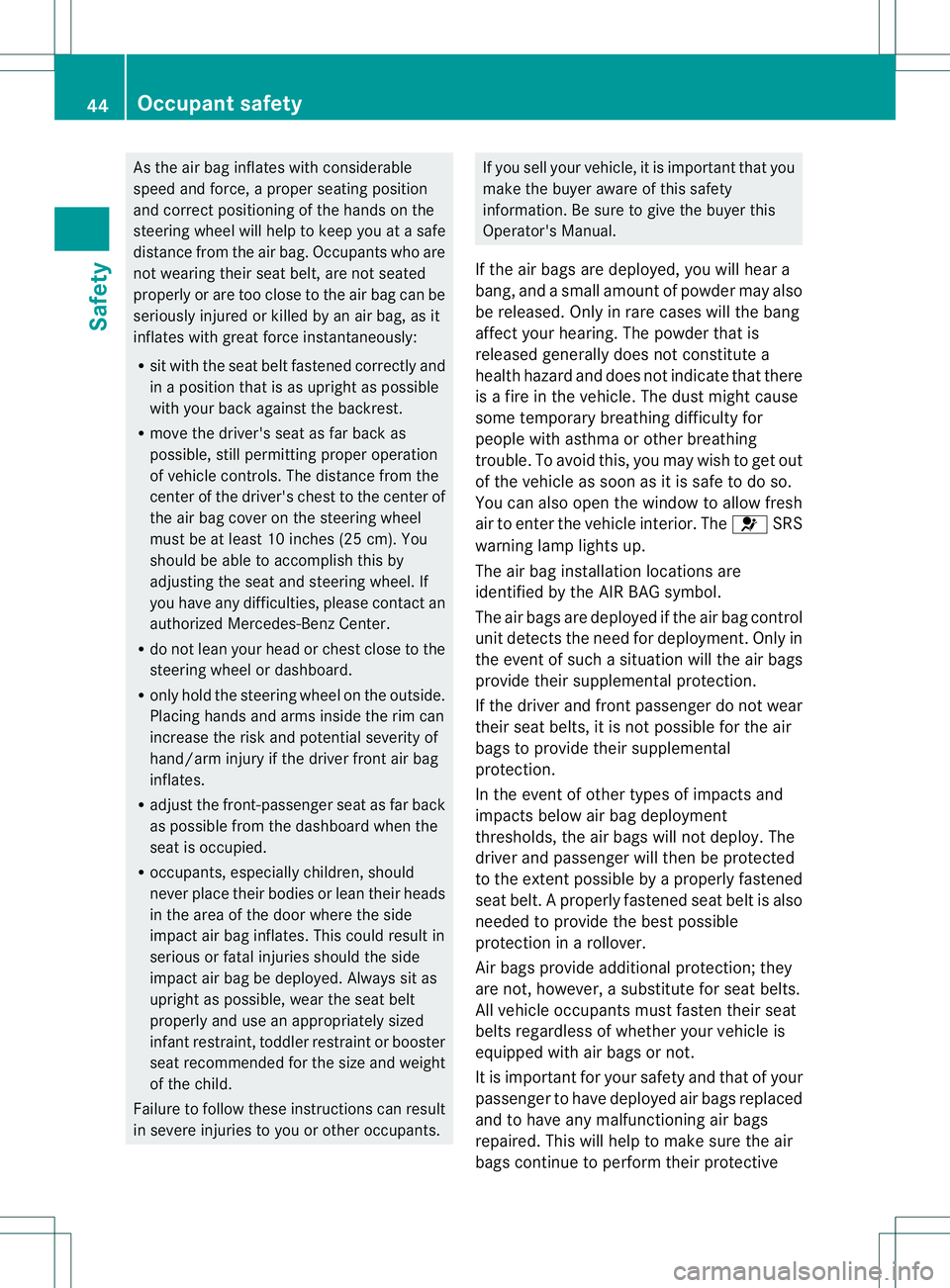
As the ai
rbag inflate swith considerable
spee dand force, aproper seating position
and correc tpositioning of th ehands on the
steering wheel will help to keep you at asafe
distanc efromt heair bag. Occupants who are
no tw earing their seat belt, are not seated
properly or are too close to the air bag can be
seriously injured or killed by an air bag, as it
inflates with great forc einstantaneously:
R sit with the seat belt fastened correctly and
in ap osition that is as upright as possible
with your back against the backrest.
R move the driver's seat as far back as
possible, still permitting proper operation
of vehicle controls. The distanc efrom the
center of the driver's chest to the center of
the air bag cover on the steerin gwheel
must be at least 10 inches (25 cm). You
should be able to accomplish this by
adjustin gthe seat and steerin gwheel. If
you have any difficulties, please contact an
authorized Mercedes-Benz Center.
R do not lean your head or chest close to the
steerin gwheel or dashboard.
R only hold the steerin gwheel on the outside.
Placing hands and arms inside the rim can
increase the risk and potential severit yof
hand/arm injury if the driver fron tair bag
inflates.
R adjust the front-passenger seat as far back
as possible from the dashboard when the
seat is occupied.
R occupants, especially children ,should
never place their bodies or lean their heads
in the area of the door where the side
impact air bag inflates .This could result in
serious or fatal injuries should the side
impact air bag be deployed. Always sit as
upright as possible, wear the seat belt
properly and use an appropriately sized
infant restraint,t oddler restraint or booster
seat recommended for the size and weight
of the child.
Failure to follow these instructions can result
in severe injuries to you or other occupants. If you sell your vehicle, it is important that you
make the buyer aware of this safety
information. Be sure to give the buyer this
Operator's Manual.
If the air bags are deployed, you will hear a
bang, and asmall amount of powder may also
be released. Only in rare cases will the bang
affect your hearing. The powder that is
released generally does not constitute a
health hazard and does not indicate that there
is af ire in the vehicle. The dust might cause
some temporary breathing difficulty for
people with asthma or other breathing
trouble. To avoid this, you may wish to get out
of the vehicle as soon as it is safe to do so.
You can also open the window to allow fresh
air to enter the vehicle interior. The 0021SRS
warning lamp lights up.
The air bag installation locations are
identified by the AIR BAG symbol.
The air bags are deployed if the air bag control
unit detects the need for deployment.O nly in
the event of such asituatio nwill the air bags
provide their supplemental protection.
If the drive rand front passenge rdonot wear
their seat belts, it is not possible for the air
bags to provide their supplemental
protection.
In the event of other types of impacts and
impacts below air bag deployment
thresholds, the air bags will not deploy. The
driver and passenger will then be protected
to the extentp ossible byaproperly fastened
seat belt. Aproperl yfastened seat beltisa lso
needed to provide the best possible
protection in arollover.
Air bags provide additional protection; they
are not, however, asubstitute for seat belts.
All vehicle occupants must fasten their seat
belts regardless of whether your vehicle is
equipped with air bags or not.
It is important for your safety and that of your
passenger to have deployed air bags replaced
and to have any malfunctioning air bags
repaired. This will help to make sure the air
bags continue to perform their protective 44
Occupant safetySafety
Page 48 of 360
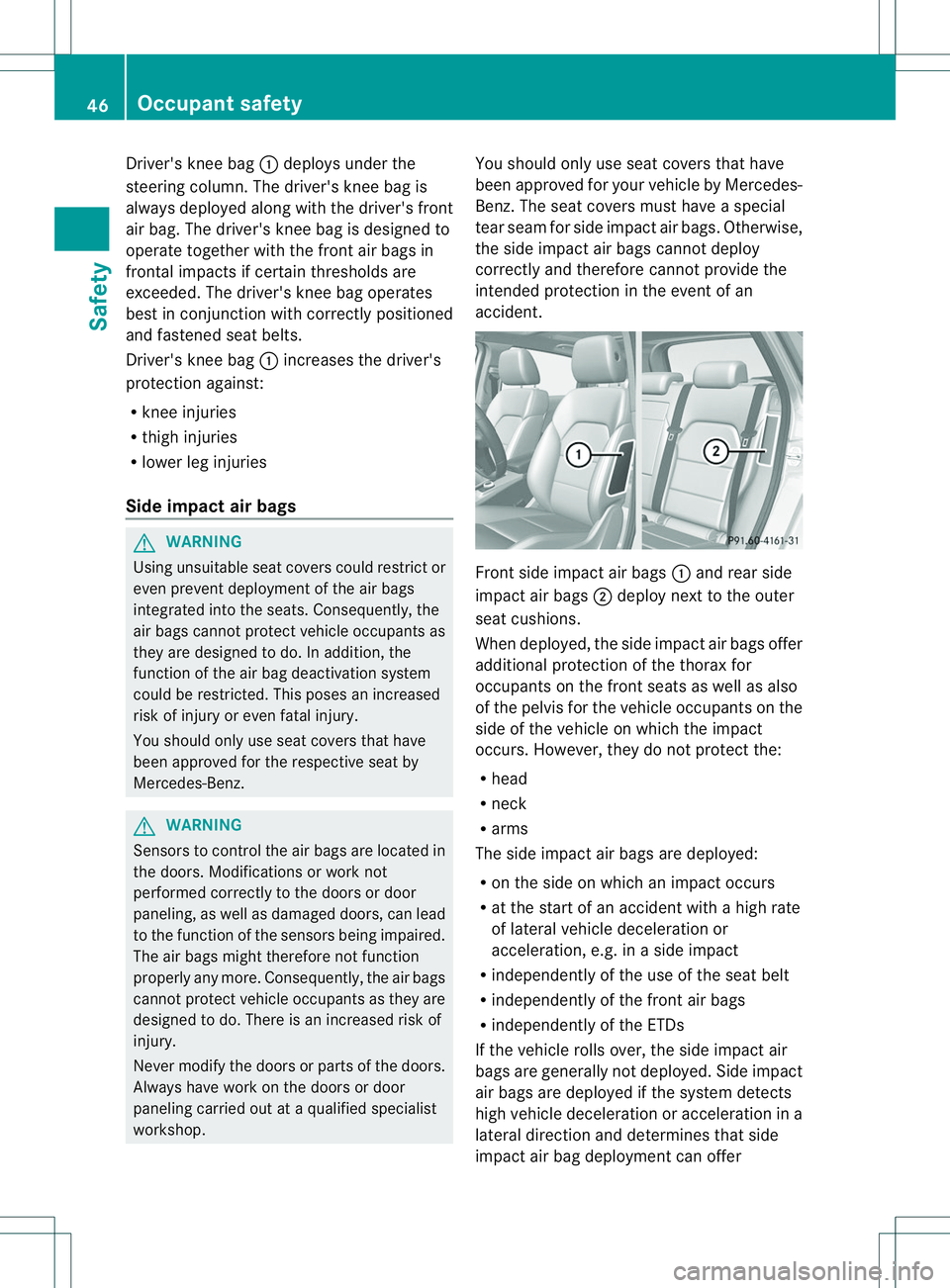
Driver's knee bag
001Adeploy sunder the
steering column. Th edriver's knee ba gis
always deployed along with the driver's front
ai rb ag. The driver' skneeb ag is designe dto
operate together wit hthe fron tair bags in
frontal impacts if certain thresholds are
exceeded. The driver's knee bag operates
best in conjunction with correctly positioned
and fastened seat belts.
Driver' skneeb ag001A increases the driver's
protection against:
R knee injuries
R thig hinjuries
R lower leg injuries
Side impact air bags G
WARNING
Usin gunsuitable seat covers could restric tor
even preven tdeployment of the air bags
integrated into the seats. Consequently, the
air bags cannot protec tvehicle occupant sas
they are designed to do. In addition, the
function of the air bag deactivation system
could be restricted. This poses an increased
risk of injury or even fatal injury.
You should only use seat cover sthat have
been approved for the respective seat by
Mercedes-Benz. G
WARNING
Sensors to control the air bags are located in
the doors. Modification sorwork not
performed correctly to the doors or door
paneling, as well as damaged doors, can lead
to the function of the sensor sbeing impaired.
The air bags might therefore not function
properly any more. Consequently, the air bags
cannot protec tvehicle occupant sasthey are
designed to do. There is an increased risk of
injury.
Never modify the doors or parts of the doors.
Always have work on the doors or door
paneling carried out at aqualified specialist
workshop. You should only use seat cover
sthat have
been approved for your vehicle by Mercedes-
Benz .The seat covers must have aspecial
tear seam for side impact air bags. Otherwise,
the side impact air bags cannot deploy
correctly and therefore cannot provide the
intended protection in the event of an
accident. Front side impact air bags
001Aand rear side
impact air bags 0010deploy next to the outer
seat cushions.
When deployed, the side impact air bags offer
additional protection of the thorax for
occupants on the front seats as well as also
of the pelvis for the vehicle occupants on the
side of the vehicle on which the impact
occurs. However, they do not protect the:
R head
R neck
R arms
The side impact air bags are deployed:
R on the side on which an impact occurs
R at the start of an accident with ahigh rate
of lateral vehicle deceleration or
acceleration, e.g. in aside impact
R independently of the use of the seat belt
R independently of the front air bags
R independently of the ETDs
If the vehicle rolls over ,the side impac tair
bags are generally not deployed. Side impact
air bags are deployed if the system detects
high vehicle deceleration or acceleration in a
lateral direction and determines that side
impac tair bag deploymen tcan offer 46
Occupant safetySafety
Page 50 of 360
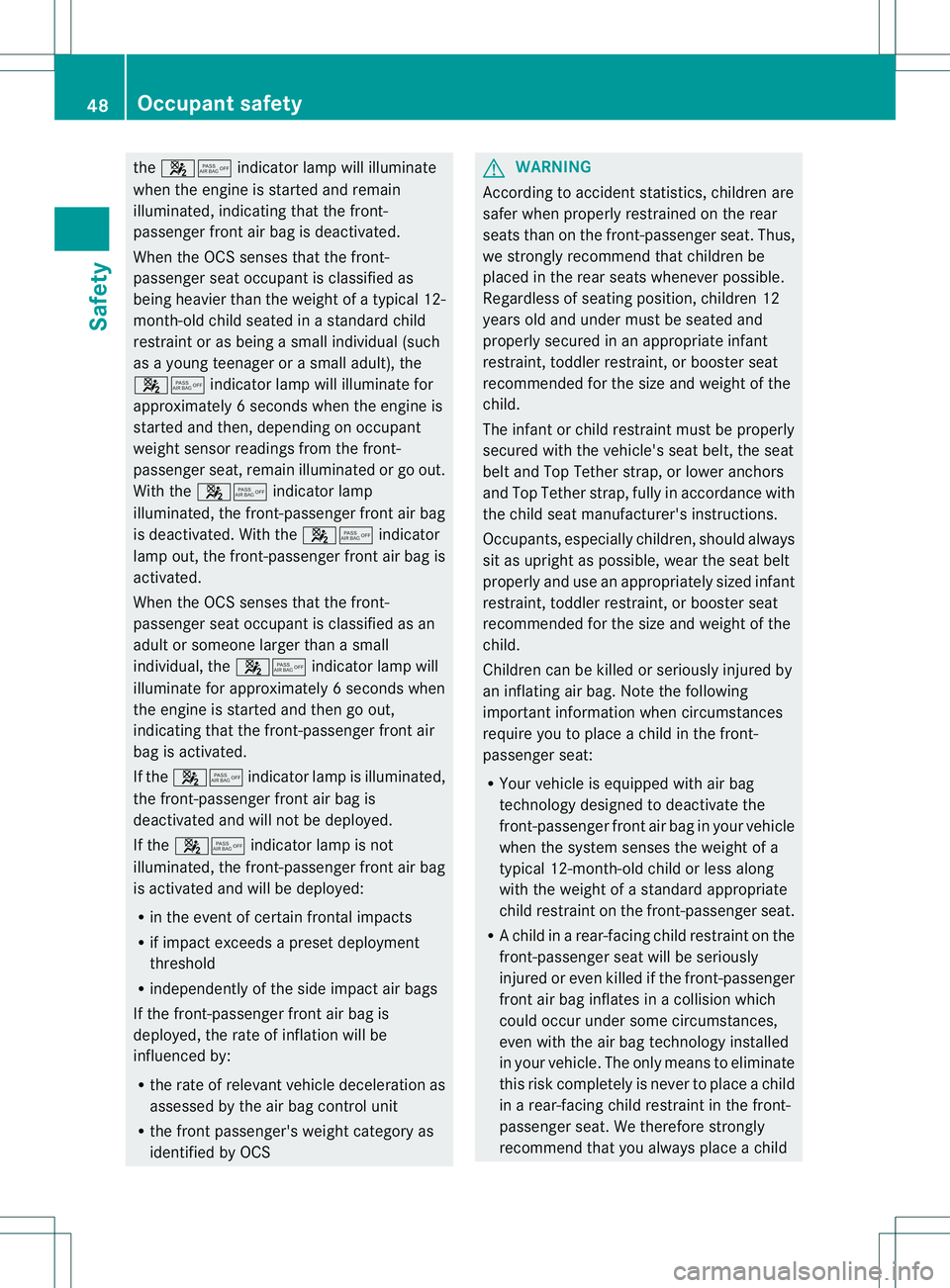
the
000E0013 indicator lamp will illuminate
when the engine is started and remain
illuminated, indicating tha tthe front-
passenger front air bag is deactivated.
When the OCS senses that the front-
passenger seat occupant is classified as
being heavier than the weight of atypical 12-
month-old child seated in astandar dchild
restraint or as being asmall individual (such
as ayoung teenager or asmall adult), the
000E0013 indicator lamp willi lluminate for
approximatel y6seconds when the engine is
started and then ,depending on occupant
weight sensor readings from the front-
passenger seat, remain illuminated or go out.
With the 000E0013 indicator lamp
illuminated, the front-passenger fron tair bag
is deactivated. With the 000E0013indicator
lamp out, the front-passenge rfront air bag is
activated.
When the OCS senses that the front-
passenger seat occupant is classifie dasan
adult or someone larger than asmall
individual, the 000E0013indicator lamp will
illuminate for approximatel y6seconds when
the engine is started and then go out,
indicating that the front-passenger fron tair
bag is activated.
If the 000E0013 indicator lamp is illuminated,
the front-passenger fron tair bag is
deactivated and will not be deployed.
If the 000E0013 indicator lamp is not
illuminated, the front-passenger fron tair bag
is activate dand will be deployed:
R in the even tofcertain frontal impacts
R if impact exceeds apreset deployment
threshold
R independently of the side impact air bags
If the front-passenge rfront air bag is
deployed, the rate of inflation will be
influenced by:
R the rate of relevant vehicle deceleratio nas
assessed by th eair bag control unit
R thef ront pa ssenger's weigh tcategor yas
identified by OCS G
WARNING
Accordin gtoacciden tstatistics, childre nare
safe rwhen properly restrained on the rear
seats than on the front-passenger seat. Thus,
we strongly recommendt hat children be
placed in the rear seats whenever possible.
Regardless of seating position, children 12
years old and under must be seated and
properly secured in an appropriate infant
restraint,t oddler restraint,orb ooster seat
recommended for the size and weight of the
child.
The infant or child restraint must be properly
secured with the vehicle's seat belt, the seat
belt and Top Tether strap, or lower anchors
and Top Tether strap, fully in accordance with
the child seat manufacturer's instructions.
Occupants, especially children, should always
sit as upright as possible, wear the seat belt
properly and use an appropriately sized infant
restraint,t oddler restraint,orb ooster seat
recommended for the size and weight of the
child.
Children can be killed or seriously injured by
an inflating air bag. Note the following
important information when circumstances
require you to place achild in the front-
passenger seat:
R Your vehicle is equipped with air bag
technology designed to deactivate the
front-passenger front air bag in your vehicle
when the system senses the weight of a
typical 12-month-old child or less along
with the weight of astandard appropriate
child restraint on the front-passenger seat.
R Ac hild in arear-facing child restraint on the
front-passenger seat will be seriously
injured or even killed if the front-passenger
front air bag inflates in acollision which
could occur under some circumstances,
even with the air bag technology installed
in your vehicle. The only means to eliminate
this risk completely is never to place achild
in ar ear-facing child restraint in the front-
passenger seat. We therefore strongly
recommendt hat you always place achild 48
Occupant safetySafety
Page 58 of 360
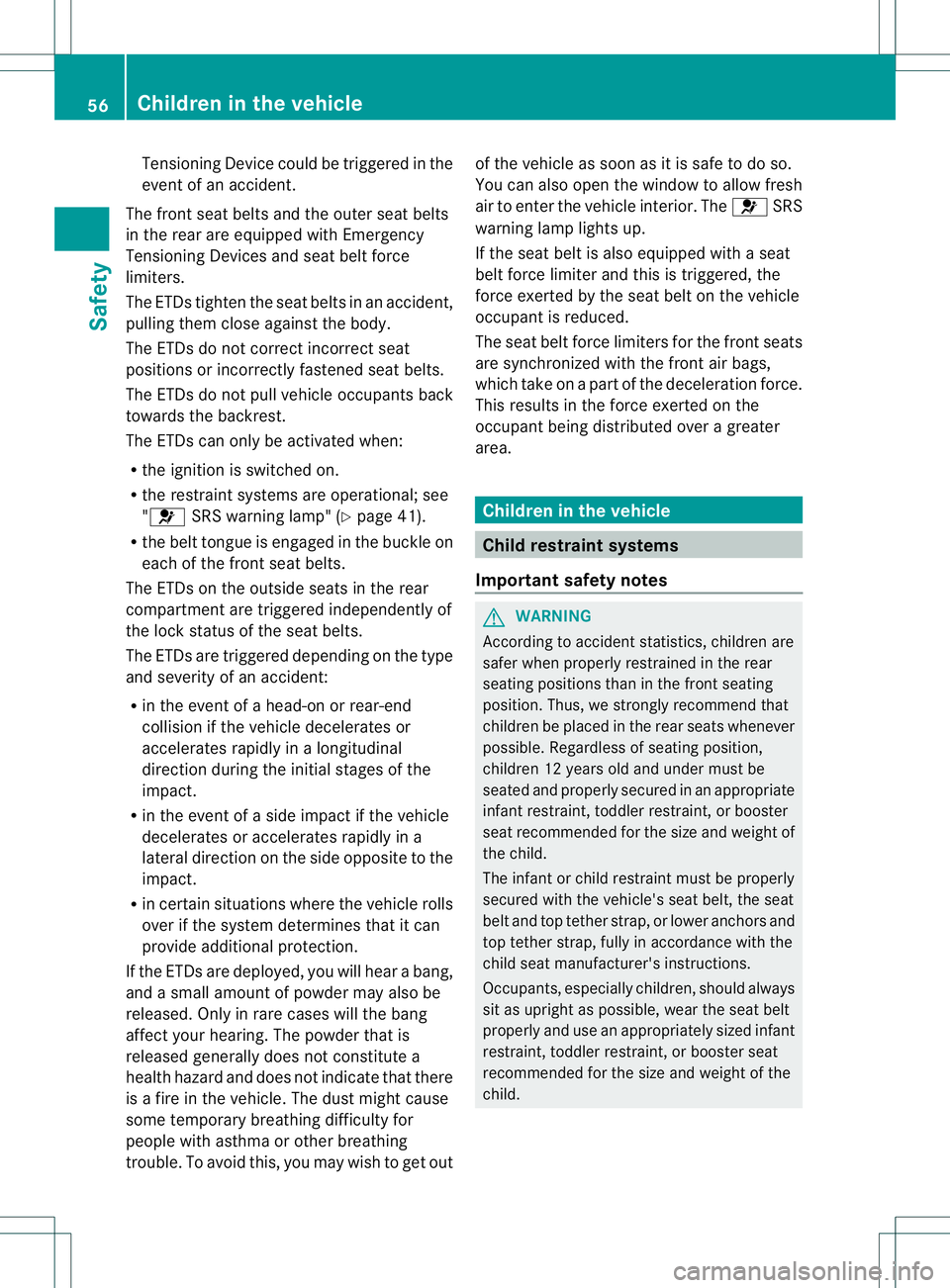
Tensionin
gDevice could be triggered in the
event of an accident.
The fronts eat belts and the outer seat belts
in the rear are equipped with Emergency
Tensioning Devices and seat belt force
limiters.
The ETDst ighten the seat belts in an accident,
pulling them close against the body.
The ETDsdon ot correct incorrect seat
position sorincorrectly fastened seat belts.
The ETDsdon ot pull vehicle occupants back
towards the backrest.
The ETDsc an only be activated when:
R the ignition is switched on.
R the restraint systems are operational; see
"0021 SRS warning lamp" (Y page 41).
R the belt tongue is engaged in the buckle on
each of the fron tseat belts.
The ETDsont he outside seats in the rear
compartment are triggered independently of
the lock status of the seat belts.
The ETDsa re triggered depending on the type
and severit yofanaccident:
R in the event of ahead-on or rear-end
collision if the vehicle decelerates or
accelerates rapidly in alongitudinal
direction during the initial stages of the
impact.
R in the event of aside impact if the vehicle
decelerates or accelerates rapidly in a
lateral direction on the side opposite to the
impact.
R in certain situation swhere the vehicle rolls
over if the system determines that it can
provide additional protection.
If the ETDsa re deployed, you will hear abang,
and asmall amount of powder may also be
released. Only in rare cases will the bang
affect your hearing. The powder that is
released generally does not constitute a
health hazard and does not indicat ethat there
is af ire in the vehicle. The dust might cause
some temporary breathin gdifficult yfor
people with asthma or other breathing
trouble. To avoid this, you may wish to get out of the vehicle as soon as it is safe to do so.
You can also open the window to allow fresh
air to enter the vehicle interior. The
0021SRS
warning lamp lights up.
If the seat belt is also equipped with aseat
belt forc elimiter and this is triggered, the
forc eexerted by the seat belt on the vehicle
occupant is reduced.
The seat belt force limiters for the front seats
are synchronized with the front air bags,
which take on apart of the deceleration force.
This results in the force exerted on the
occupant being distributed over agreater
area. Children in the vehicle
Child restraint systems
Important safety notes G
WARNING
According to accident statistics, children are
safer when properly restrained in the rear
seating positions than in the front seating
position. Thus, we strongly recommend that
children be placed in the rear seats whenever
possible.R egardless of seating position,
children 12 years old and under must be
seated and properly secured in an appropriate
infant restraint, toddler restraint, or booster
seat recommended for the size and weight of
the child.
The infant or child restraint must be properly
secured with the vehicle's seat belt, the seat
belt and top tether strap, or lower anchor sand
top tether strap, fully in accordance with the
child seat manufacturer's instructions.
Occupants, especially children ,should always
sit as upright as possible, wear the seat belt
properly and use an appropriately sized infant
restraint, toddler restraint, or booster seat
recommended for the size and weight of the
child. 56
Children in thev
ehicleSafety
Page 61 of 360
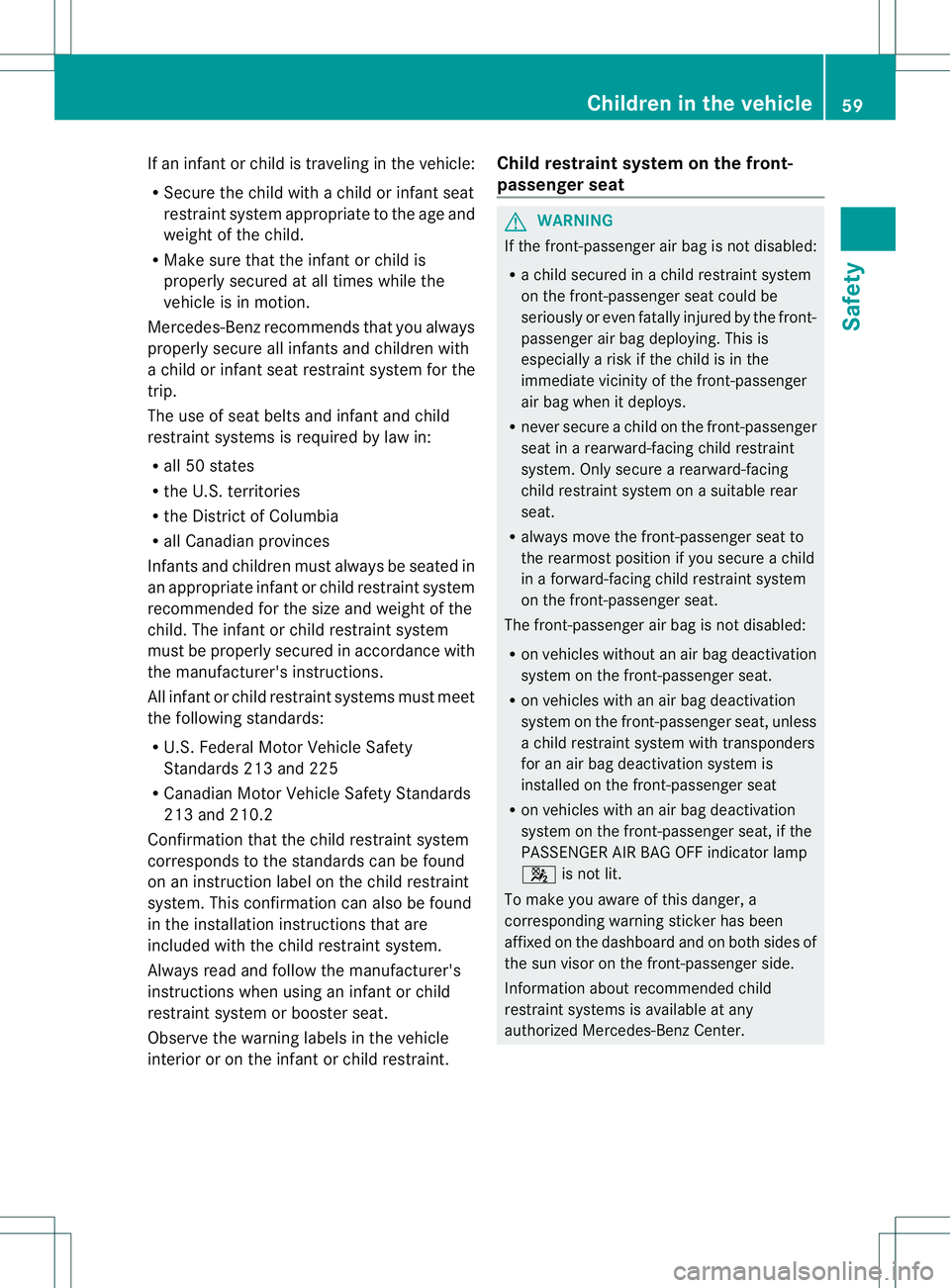
If an infant or child is traveling in the vehicle:
R
Secure the child with achild or infant seat
restraint system appropriate to the age and
weight of the child.
R Make sure that the infant or child is
properl ysecured at all times whilet he
vehicle is in motion.
Mercedes-Benz recommends that you always
properl ysecure all infants and childre nwith
ac hild or infant seat restraint system for the
trip.
The use of seat belts and infant and child
restraint systems is require dbylaw in:
R all 50 states
R the U.S .territories
R the Distric tofColumbia
R all Canadia nprovinces
Infants and children must alwaysbes eated in
an appropriate infant or child restraint system
recommende dfor the size and weight of the
child .The infant or child restraint system
must be properly secured in accordance with
the manufacturer's instructions.
All infant or child restraint systems must meet
the following standards:
R U.S. Federal Motor Vehicle Safety
Standards 213 and 225
R CanadianM otor Vehicle Safety Standards
213 and 210.2
Confirmation that the child restraint system
corresponds to the standards can be found
on an instruction label on the child restraint
system. This confirmation can also be found
in the installation instructions that are
included with the child restraint system.
Always read and follow the manufacturer's
instructions when using an infant or child
restraint system or booster seat.
Observe the warning labels in the vehicle
interior or on the infant or child restraint. Child restraint system on the front-
passenger seat G
WARNING
If the front-passenger air bag is not disabled:
R ac hild secured in achild restraint system
on the front-passenger seat could be
seriously or even fatally injured by the front-
passenger air bag deploying. This is
especially arisk if the child is in the
immediate vicinit yofthe front-passenger
air bag when it deploys.
R never secure achild on the front-passenger
seat in arearward-facing child restraint
system. Only secure arearward-facing
child restraint system on asuitable rear
seat.
R alway smove the front-passenger seat to
the rearmost position if you secure achild
in af orward-facin gchild restraint system
on the front-passenger seat.
The front-passenger air bag is not disabled:
R on vehicles without an air bag deactivation
system on the front-passenger seat.
R on vehicles with an air bag deactivation
system on the front-passenger seat, unless
ac hild restraint system with transponders
for an air bag deactivation system is
installed on the front-passenger seat
R on vehicles with an air bag deactivation
system on the front-passenger seat, if the
PASSENGER AIR BAG OFF indicator lamp
000E is not lit.
To make you aware of this danger, a
corresponding warning sticker has been
affixed on the dashboard and on both sides of
the sun visor on the front-passenger side.
Information about recommended child
restraint systems is available at any
authorized Mercedes-Benz Center. Children in the vehicle
59Safety Z
Page 65 of 360

X
To activate/deactivate: press button001A.
If indicator lamp is lit, operatio nofthe rear
side windows is disabled. Operation is only
possible using the switches in the driver's
door. If the indicator lamp is off, operation
is possible using the switches in the rear
compartment. Driving safety systems
Overview of driving safety systems
In this section, you will find information about
the following driving safety systems:
R ABS ( Anti-lock BrakingSystem)
(Y page 70)
R BAS ( Brake Assist System) (Y page 64)
R COLLISION PREVENTION ASSIST (adaptive
Brake Assist and distance warning signal)
(Y page 64)
R Adaptive brake lights (Y page 67)
R ESP ®
(Electronic StabilityProgram)
(Y page 67)
R EBD ( Electronic Brake force Distribution)
(Y page 69)
R ADAPTIVE BRAKE (Y page 69)
(Y page 69)
R STEERC ONTROL (Y page 70) Important safety notes
If you fail to adapt your driving style or
become distracted, the driving safety
systems can neither reduce the risk of accident nor override the laws of physics.
Driving safety systems are merely aids
designed to assist driving. You are
responsible for the distance to the vehicle in
front,f
or vehicle speed and for braking in
good time. Always adapt your driving style to
suit the prevailing road, weather and traffic
conditionsa nd maintain asafe distanc efrom
th ev ehicle in front. Drive carefully.
i The driving safety systems describe donly
work as effectivel yaspossible when there
is adequat econtac tbetween th etires and
th er oad surface. Pay particular attention
to th einformatio nregarding tires,
recommended minimum tire tread depths
etc.int he "Wheels and tires" section
(Y page 312).
In wintry driving conditions, always use
winter tires (M+S tires) and if necessary,
snow chains. Only in this way will the
driving safety systems described in this
section work as effectively as possible. ABS (Anti-lockB
raking System)
General information ABS regulate
sbrake pressure in such away
tha tthe wheels do not lock when you brake.
This allowsy ou to continue steering the
vehicle when braking.
The 001C ABS warning lamp in the instrument
cluster lights up when the ignition is switched
on. It goes out when the engine is running.
Important safety notes i
Observe the "Important safety notes"
section for driving safety systems
(Y page 63). G
WARNING
If ABS is faulty, the wheels could lock when
braking. The steerability and braking
characteristics may be severely impaired.
Additionally, further driving safety systems Driving safety systems
63Safety
Z